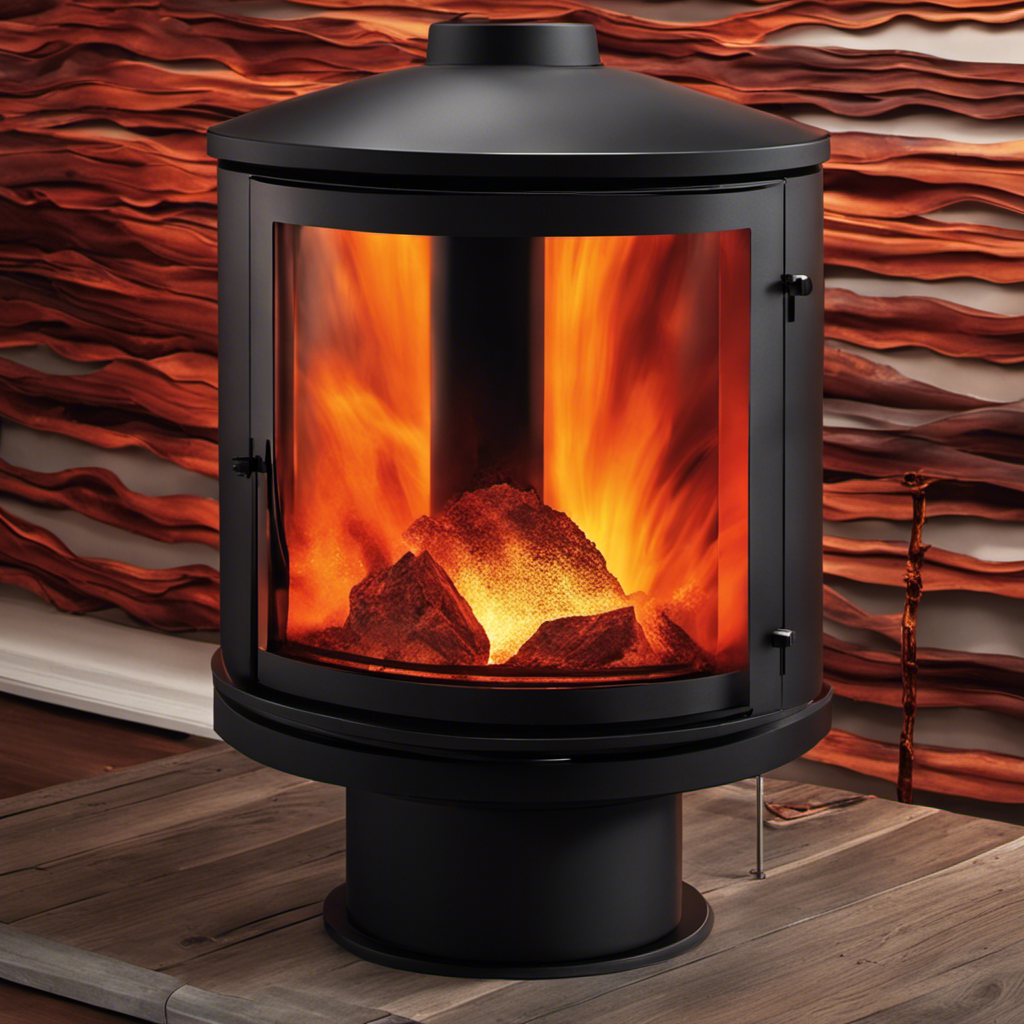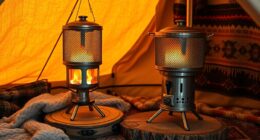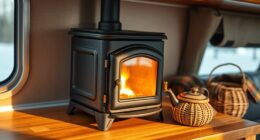Were you aware that wood stove pipes can reach extremely high temperatures? They are known to reach up to 1,000 degrees Fahrenheit!
Understanding the factors that influence these extreme temperatures is crucial for safe and efficient wood stove operation. In this article, I will delve into the various elements that affect wood stove pipe temperature, discuss heat transfer mechanisms, and provide tips for monitoring and controlling these high temperatures.
Let’s explore the world of wood stove pipe heat together.
Key Takeaways
- Factors affecting wood stove pipe temperature include the type of fuel, chimney height, and outside temperature.
- Understanding heat transfer in wood stove pipe involves considering conduction of heat, thermal conductivity of pipe material, and monitoring temperature along the pipe.
- Different types of wood stove pipe have varying maximum temperature limits, and exceeding these limits can result in structural damage and reduced efficiency.
- Proper insulation for wood stove pipe is important to reduce heat loss, promote better draft, prevent condensation and corrosion, and ensure a safer environment.
Factors Affecting Wood Stove Pipe Temperature
I’ve noticed that one of the factors affecting wood stove pipe temperature is the type of fuel being used. Different types of fuel burn at different temperatures, which in turn affects the temperature of the stove pipe. For example, hardwoods like oak or maple burn hotter and produce more heat compared to softwoods like pine or cedar. This means that the stove pipe temperature will be higher when burning hardwoods.
Another factor that affects wood stove pipe temperature is the chimney height. The height of the chimney determines the draft and airflow, which affects the efficiency of the stove and the heat transfer to the pipe. A taller chimney will create a stronger draft, resulting in better combustion and higher stove pipe temperatures. On the other hand, a shorter chimney may not generate enough draft, leading to lower temperatures in the pipe.
Lastly, the outside temperature also impacts the heat retention in the wood stove pipe. In colder climates, the pipe may cool down quicker, resulting in lower temperatures. Conversely, in warmer climates, the pipe may retain heat better, leading to higher temperatures. It’s essential to consider the outside temperature when monitoring and adjusting the wood stove pipe temperature for optimal performance.
Understanding Heat Transfer in Wood Stove Pipe
Observing the temperature changes along the length of the wood stove pipe, I can gain a better understanding of heat transfer in this system. Heat distribution plays a crucial role in ensuring the efficient operation of a wood stove.
As the hot gases rise through the pipe, they transfer heat to the surrounding metal. This process, known as conduction, is dependent on the thermal conductivity of the pipe material. Metals such as stainless steel or cast iron, with high thermal conductivity, allow for effective heat transfer.
By monitoring the temperature along the pipe, we can assess the efficiency of heat distribution. If certain sections of the pipe are significantly cooler than others, it may indicate poor heat transfer or insulation issues.
Understanding heat transfer and maintaining proper heat distribution is essential for ensuring the optimal performance of a wood stove.
Maximum Temperature Limits for Wood Stove Pipe
Fortunately, the maximum temperature limits for wood stove pipe are clearly defined to ensure safe operation. It is crucial to understand these limits in order to prevent potential risks and hazards. Exceeding the safe operating temperatures for wood stove pipes can lead to several problems, including structural damage, reduced efficiency, and increased risk of fire. To illustrate this, let’s take a look at the following table:
| Pipe Material | Maximum Temperature Limit |
|---|---|
| Single Wall | 600°F |
| Double Wall | 1000°F |
| Insulated Double Wall | 2100°F |
As shown in the table, different types of wood stove pipe have varying maximum temperature limits. It is crucial to choose the appropriate pipe material for your specific stove to ensure safe operation. Exceeding these limits can result in pipe failure, which can lead to dangerous situations such as chimney fires. In the next section, we will discuss the importance of proper insulation for wood stove pipes, which plays a significant role in maintaining safe operating temperatures and preventing excessive heat transfer.
Importance of Proper Insulation for Wood Stove Pipe
Proper insulation is crucial for maintaining safe operating temperatures and preventing excessive heat transfer in wood stove pipes. Insulation materials for wood stove pipes play a vital role in ensuring the efficiency and safety of the system.
Here are some key benefits of insulating wood stove pipes:
- Reduced heat loss: Insulating the pipe helps to minimize heat loss during the transfer of exhaust gases, allowing more heat to be retained within the stove and the living space.
- Increased draft: Insulation promotes a better draft by maintaining the temperature of the flue gases, ensuring a steady flow of combustion byproducts up the chimney.
- Prevention of condensation: Insulation prevents the formation of condensation within the pipe, which can lead to corrosion and damage over time.
- Enhanced safety: By reducing the external temperature of the pipe, insulation minimizes the risk of accidental burns and protects nearby combustible materials from excessive heat exposure.
Properly insulating wood stove pipes not only improves the efficiency of the heating system but also ensures a safer and more comfortable environment.
Tips for Monitoring and Controlling Wood Stove Pipe Temperature
I find it helpful to regularly check and adjust the wood stove pipe temperature to ensure optimal performance and safety. Monitoring the temperature of the wood stove pipe is crucial to prevent any potential issues such as overheating or poor ventilation.
One of the most important tips for cleaning wood stove pipe is to schedule regular maintenance and inspection. This includes checking for any blockages or creosote buildup, which can lead to chimney fires.
Another common mistake to avoid when using a wood stove pipe is neglecting to adjust the damper properly. This can result in excessive heat and increased risk of fire.
It’s also essential to use the correct size and type of wood for your wood stove to maintain a consistent and manageable temperature.
Frequently Asked Questions
How Do I Clean and Maintain My Wood Stove Pipe to Ensure It Operates at Optimal Temperature?
To ensure optimal temperature, I clean and maintain my wood stove pipe regularly. This involves removing creosote buildup with a chimney brush and inspecting for any cracks or leaks. Proper maintenance is crucial for safe and efficient operation.
Can I Use Any Type of Wood in My Wood Stove, or Are There Certain Types That Burn Hotter and Affect the Pipe Temperature?
Certain types of wood burn hotter and can affect the temperature of the wood stove pipe. Factors like moisture content, density, and BTU output play a role. Using the right wood ensures optimal performance.
Is It Safe to Install a Wood Stove Pipe Near Combustible Materials, Such as Wood Paneling or Drywall?
It is not safe to install a wood stove pipe near combustible materials such as wood paneling or drywall. The high temperature of the pipe can pose a fire hazard and increase the risk of ignition.
Are There Any Safety Precautions I Should Take to Prevent Overheating of the Wood Stove Pipe?
To prevent overheating of the wood stove pipe, I recommend insulating it properly. This will help maintain safe temperatures and reduce the risk of damage to surrounding combustible materials. Safety first!
Can I Use a Wood Stove Pipe in an Outdoor Setting, Such as a Patio or Covered Porch?
Yes, you can use a wood stove pipe in an outdoor setting like a patio or covered porch. However, keep in mind that the temperature of the wood stove pipe can get extremely hot, so take necessary safety precautions.
Conclusion
Well, folks, it turns out that wood stove pipe temperatures can get hotter than the devil’s underwear on a scorching summer day.
Understanding the factors that affect heat transfer in the pipe is crucial for keeping things under control.
Remember, proper insulation is key to preventing any fiery mishaps.
So, keep an eye on that temperature gauge and make sure your wood stove pipe doesn’t turn into a volcano.
Stay cool, my friends!
Growing up surrounded by the vast beauty of nature, Sierra was always drawn to the call of the wild. While others sought the comfort of the familiar, she ventured out, embracing the unpredictable and finding stories in the heartbeat of nature.
At the epicenter of every remarkable venture lies a dynamic team—a fusion of diverse talents, visions, and passions. The essence of Best Small Wood Stoves is crafted and refined by such a trio: Sierra, Logan, and Terra. Their collective expertise has transformed the platform into a leading authority on small wood stoves, radiating warmth and knowledge in equal measure.











